Civic Arts
Art is the next big thing
July 24, 2014
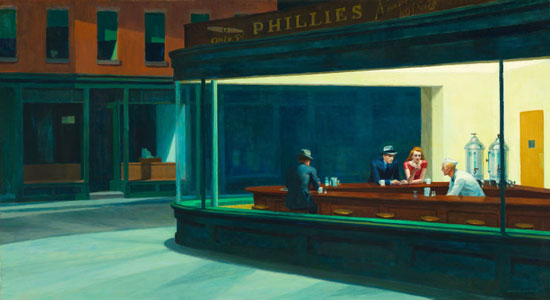
"Nighthawks," from the collection of the Art Institute of Chicago, will be seen in L.A. and nationwide.
Edward Hopper’s moody “Nighthawks” will be having their after-hours cups of java on a wall in San Francisco—and at 18 feet high by 50 feet wide, they’ll be hard to miss.
Grant Wood’s dour duo from “American Gothic” will be living large on the staircase of New York’s Port Authority.
And here in L.A., rush hour traffic will be getting a jolt of cultural uplift as buses rumble by wrapped in iconic works like Ed Ruscha’s “Hollywood.”
Just like millions of vacationers, American art is hitting the road this summer.
Starting August 4, 58 masterpieces will be breaking out of five major museums and onto the streets. The exhibition, called Art Everywhere US, is modeled after a similar show in the United Kingdom and is intended to create what the organizers call a “free, open-air art gallery across the country” throughout the month of August.
The featured reproductions include 11 pieces from the Los Angeles County Museum of Art. Among them: Andy Warhol’s “Campbell’s Soup Can,” Roy Lichtenstein’s “Cold Shoulder,” Willem de Kooning’s “Montauk Highway” and Mark Rothko’s “White Center.”
But L.A.’s al fresco gallery won’t be limited to the LACMA works; all 58 of the featured pieces will be on display here at some 500 locations around town. Exact locations will be announced soon on the project’s website, where an interactive map will make spotting the masterpieces easy. There also will be an Instagram contest for people to show off selfies they’ve taken with the oversized artworks.
In addition to the wrapped buses, “the digital billboards in L.A. will be featuring the art works,” said Stephen J. Freitas, chief marketing officer of the Outdoor Advertising Association of America, which is collaborating on the project with LACMA, the Art Institute of Chicago, the National Gallery, the Whitney and the Dallas Museum of Art. “We’ve got a wonderful Warhol that’s going to be coming your way on a lot of bus shelters.”
Nationwide, the art is being displayed in all 50 states on donated billboard and other advertising space valued at tens of millions of dollars, Freitas said. The effort started with 100 works of art suggested by the museums; members of the public then had a chance to vote on their favorites to winnow down the list to the final 58.
Taken together, the pieces represent a kind of American Art 101—from Gilbert Stuart’s portrait of George Washington to Robert Mapplethorpe’s portrait of “Ken Moody and Robert Sherman.”
“It’s a great opportunity not only for LACMA to represent Los Angeles, but to show its history through a painting like Millard Sheets’ ‘Angel’s Flight,’ or Ed Ruscha’s depiction of the Hollywood sign,” said Michael Govan, LACMA’s director and CEO.
And you don’t need to be an art history major to enjoy it.
“We’re hoping this campaign will help drive more interest in American art and drive people to more American museums to see art in person. But we also think it’s a great way to just give people a lift in their day, give them something unexpected on their way to work or traveling down the road,” Freitas said. “We think it will inspire a little happiness in American life, we hope, for a few days or a few moments.”
Posted 7/24/14
L.A.’s cool summer hotspot
May 30, 2014
A crowd of 4,000 showed up to Grand Park for a salsa festival on Memorial Day, the unofficial start of summer. The dancers were sizzling, but the park is just getting warmed up— in the coming months, many more fun times are planned for downtown L.A.’s newest public space.
Park programming director Julia Diamond said she tries to cast a wide net when planning events.
“We go for a broad spectrum so that we can cater to a lot of different interests,” Diamond said. “We want people to have varied reasons to come into the park.”
The summer schedule includes three large events with smaller happenings that will take place on a regular basis. The first biggie is the 4th of July Block Party. After attracting 10,000 last year, Diamond is expecting closer to 25,000 in 2014. The event’s footprint will grow to match her expectation; several adjacent streets will be closed to accommodate the throngs. There will be DJs, live music, food and, of course, fireworks—but this year they’ll be shot from the roof of the Dorothy Chandler Pavilion so all of downtown can see the show.
After that, the next big date is July 26, when the park will celebrate National Dance Day with top performers in a variety of styles, plus a wet dance party in the park’s ever-popular splash fountain. Then, the final summer offering comes on September 28 when the Music Center presents “Universe of Sound: The Planets.” A huge tent with planetarium-style visual displays will be the setting for an interactive musical experience in which attendees will be able to conduct and play their own music as 132 live musicians perform Gustav Holst’s The Planets.
If you can’t wait until July, other fun is just around the corner—the first of four Sunday Sessions will take place this weekend, on June 1. The event will bring some of the top electronic dance music artists in SoCal to perform in a family-friendly environment so party people of all ages can get their groove on. And for those who want to create the beat themselves, “Drum Downtown” events offer percussionists of all skill levels a chance to beat the skins with guidance from pros. Equipment will be provided.
For the daytime crowd, “Lunch a la Park” brings a rotating cast of L.A.’s best gourmet food trucks on Wednesdays and Thursdays. After the workday, Grand Park’s Bootcamp can help work off any double bacon kobe sliders in which you may have indulged.
But sometimes families may just want to chillax at the end of a long summer day. The “Movies in the Dark” series hearkens back to the days of the double feature and adds games, contests and trivia competitions with prizes to the experience.
Not all events have been posted on the park’s website yet, so the best bet for those who want to attend is to keep tabs on the calendar or follow the park’s Facebook page.
It may sound like a lot of stuff will be going on, but Diamond says that the park has actually scaled back the number of events.
“We’re trying to get out of people’s way a little bit,” Diamond said. “We want people to use Grand Park just as a park.”
Diamond said the young park is starting to build solid regular attendance. The hot months of the summer are among the busiest, with the splash fountain offering a sweet way to beat the heat—and a safe place for kids to cavort while their parents kick back and sip iced lattes under palm trees atop the hot pink furniture.
Another major attraction is how photogenic the park can be. Between the Arthur J. Will Memorial Fountain, city hall and the gardens of blossoming flora from around the world, Grand Park has generated plenty of shutterbug enthusiasm, as can be seen on sites like Instagram, where its official account has more than 6,200 followers.
But Diamond hopes that when people leave they take more than snazzy snapshots with them. She wants Grand Park to become a place of nostalgia for Angelenos, a place they will remember years from now.
“I want to be in people’s memories at the end of the summer when they put that sweater on for the first time,” Diamond said. “I want them to remember that a high moment came at Grand Park.”
Posted 5/30/14
The people’s art
February 27, 2014
From a rammed earth sculpture in the high desert to glimmering bronze leaves channeling the olive groves of yesteryear, the county’s civic art collection is as diverse as Los Angeles County itself.
And it’s growing fast.
In just the past four years, the program has added 58 new artworks and restorations to its collection. The new works join a vibrant array of earlier projects commissioned and managed by the Los Angeles County Arts Commission as part of the Civic Art Program, which requires that 1% of the design and construction costs on new county capital projects be set aside for art.
Since the Board of Supervisors approved the program in December, 2004, a total of 80 projects have been completed at L.A. County facilities. And more are on the way, including the first $1 million civic art endeavor, at the Martin Luther King, Jr. Medical Campus, as well as projects at the renovated Hall of Justice and the new San Fernando Valley Family Support Center.
Margaret Bruning, who directs the program, said the aim is to “create artworks and facilities that reflect who we are as a community and a culture, where we are now—and where we think we’re going.”
“We often say that civic art is about the art of the place…But it’s more than just art in the pure sense,” she said. “It’s about people and their experience of this place and of each other. And I think that’s the civic-mindedness that comes through in civic art.”
As the program’s 10th anniversary approaches, take a spin through the photo gallery below to appreciate some of the compelling, beautiful or just plain fun artwork that has been integrated into county facilities—from swimming pools and skate parks to libraries and fire stations—over the past decade.
Posted 2/26/14
Next stop? A milestone in public art
April 11, 2013
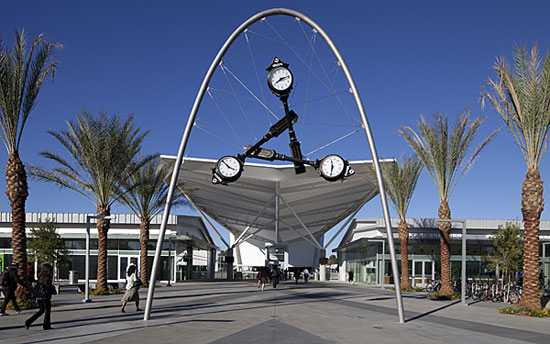
Donald Lipski's "Time Piece," part of Metro's signature art collection, greets bus travelers at the El Monte station.
As art collections go, it’s impressive, from famed sculptor Jonathan Borofsky to activist/artist Judy Baca to renowned Eastside painter Frank Romero.
The catch? You have to be traveling to see it. Oh, and a lot of it is literally underground.
The sprawling exhibition of public art that Metro has built in L.A. County’s subway, bus and commuter rail stations will celebrate its 25th anniversary next year. (Take a virtual tour in our gallery below.)
Launched in 1989 with a half-percent set-aside from rail construction costs, Metro’s award-winning collection of public transit art now encompasses work by some 120 artists in 100 stations, plus posters, photography, poetry and other temporary installations by another 180 artists. Last week, eight California artists were selected to create work for the second phase of the Expo Line, which will run to Santa Monica from the end of the first segment at Culver City.
“Art brings a unique vibrancy and vitality to L.A.’s Metro system,” says Maya Emsden, deputy executive officer for creative services at Metro, who is one of a handful of co-authors on a forthcoming American Public Transportation Association “best practices” paper on integrating art into public transit.
“Art was an integral part of the Metro rail planning process from the very start.”
Metro’s collection kicked off in 1990 with a now-highly-collectible poster by Romero to commemorate the opening of the first Metro rail line. That inaugural artwork, which depicts an old Red Car morphing into the Blue Line as classic cars, blimps and airplanes whiz around it, was followed the next year by “Unity,” a glowing, blue-and-white permanent installation of 82 fiber-optic light panels in the subway tunnel between the Metro Center and Pico Stations by Thomas Eatherton, an artist from Santa Monica.
That piece led in 1993 to a series of now-iconic permanent artworks: Borofsky’s “I Dreamed I Could Fly,” a collection of life-size fiberglass figures suspended from the ceiling of the Civic Center station; Terry Schoonhoven’s Union Station mural of “time-scapes” from Spanish galleons to Carole Lombard, sitting on a suitcase; Joyce Kozloff’s ceramic tile “film strip” murals in the 7th Street/Metro Center station; Stephen Antonakos’ hanging neon artworks at the station below Pershing Square.
Since then, the program has expanded with L.A.’s transit system, says Emsden; the new commissions for Phase 2 of the new Expo Line were selected from some 400 submittals and include such artists as Shizu Saldamando, Abel Alejandre, Susan Logoreci, Nzuji de Magalhaes, Constance Mallinson, Carmen Argote, Judithe Hernandez and Walter Hood.
Though the half-percent of construction costs that L.A. reserves is substantially smaller than transit art set-asides in Boston, New York, Portland, and most other cities with such programs, Metro has been able to stretch its allotment by integrating the artworks as much as possible into the station construction.
“One of the ways we’re able to maximize the limited budget is through early involvement in the project,” says Emsden. “This also ensures important art-related things like lighting are integrated into the station plans.”
The added efficiency of building art into a station, as opposed to going back later and retrofitting, is just one of a number of art lessons Metro has learned in the past 24-plus years. Art program staffers have learned to work closely with architects, engineers and maintenance staff to situate pieces so that maintenance of the art is taken into consideration—a matter that can be trickier in, say, a rail station than in a museum.
“The Borofsky piece, ‘I Dreamed I Could Fly’, is one of my absolute favorites,” says Emsden. “But if we were to do it again we’d make sure the figures, which are actually self-portraits of the artist, were hung in a way that we could lower them for cleaning.” The flying fiberglass figures—like everything else in the stations—get covered over time with magnetic steel transit dust that can only be removed with specialized equipment and cleansers, says Emsden.
“So every five years or so, we get up there and clean them between 2 a.m. and 4 a.m.”
Another lesson: Some kinds of art fare better in transit settings than others.
Eatherton’s 1991 light piece, for instance, has been out of order for about six years, due to the technical challenges of maintaining aging electrical elements in a hard-to-reach space. Part of a Jacqueline Dreager sculpture at the Blue Line’s Wardlow station had to be taken out because it was too close to a landscaping sprinkler and was slowly being decomposed by the water. A set of Gilbert Lujan benches at the Hollywood/Vine station had to be refurbished and then eventually removed altogether because vandals kept tagging and carving their initials into the sculpted bench backs.
However, the vast majority of the Metro projects have fared well, says Emsden, adding that even delicate images have been made transit-worthy by rendering them in materials that are sturdy enough for public artwork.
“We’ve commissioned a couple of artists whose whole body of work is on paper, but there are some amazing artisans in L.A. and elsewhere who can translate those artist’s visions into very durable materials,” says Emsden.
For example, one Canadian studio that specializes in mosaics has made detailed lino-cut prints by Sonia Romero and Daniel Gonzalez, paintings by Samuel Rodriguez and photos by Pitzer College associate art professor Jessica Polzin McCoy into intricate Metro panels made of ceramic tile.
Meanwhile, she says, the program has yielded some pleasant surprises. One was the groundswell of interest among local culture enthusiasts asking to do guided art tours. The result, in 1999, was a Docent Council whose volunteers have introduced more than 30,000 people to the art of the Metro system. Notes Emsden: “We’re the only transit agency with volunteer docents and free Metro art tours.”
Perhaps the nicest surprise, however, has been the way in which some Metro pieces have worked their way, just by word of mouth, into the public imagination. “There’s a light piece by the artist Bill Bell that, if you say a secret word into a tiny hole in the wall at the top of the escalators that go down to the Red and Purple Lines at Union Station, the piece will speak back to you,” Emsden says.
There’s no sign. There are no instructions. The artist, by design, held back the “secret word” (the names of any of the various celebrities depicted, from Rin Tin Tin to Dizzy Gillespie) and left no clue that any extra magic might be found there. “But I can’t tell you how many times I’ve seen someone going past there—a security guard, a commuter, a business person—and saying to the person next to them: ‘You gotta check this out!’ ”
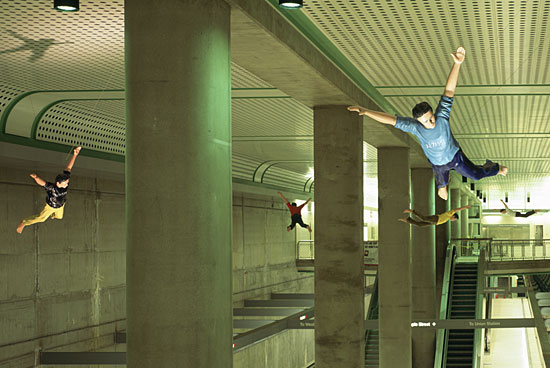
Jonathan Borofsky’s “I Dreamed I Could Fly” is an iconic—though hard to clean—part of the Civic Center Station.
Public art and public transit come together in the following gallery. All images courtesy Metro.
Posted 4/11/13
A Modernist icon and the kid next door
August 28, 2012

The Hall of Records is a mid-Century classic in the heart of downtown—but its upkeep is an ongoing challenge.
As the county Hall of Records hits the big 5-0 this year, it’s getting a youthful new neighbor and a second look by a public that’s been largely unaware of its towering architectural stature—and its aging condition.
Unbeknownst to many in the Civic Center crowd, the 1962 building is a striking example of Modernist architecture and ahead-of-its-time eco-design by the legendary Richard Neutra with his then-partner Robert Alexander.
Now that Grand Park, with its splashy pink furniture and high visibility quotient, is set to open its next segment right next door to the Hall of Records on September 11, a new generation of Angelenos is about to meet up with a structure that Los Angeles Times architecture critic Christopher Hawthorne describes as being “among the most underrated modernist buildings in Los Angeles.” There’s even talk of screening outdoor movies and concert simulcasts on the Hall of Records wall that faces the new Community Terrace section of the park.
“Bringing more people into the area is a good thing and will change how people view [the building],” said Linda Dishman, executive director of the Los Angeles Conservancy. Although she says the Hall of Records is “very much admired”—and eligible for listing on the California Register of historic resources—it’s less visible than other downtown Modernist favorities like architect A.C. Martin’s Department of Water and Power Building, not to mention Frank Gehry’s internationally acclaimed Walt Disney Concert Hall.
“Buildings that people can see from the freeway, they really tend to care about,” Dishman said.
Although it’s been keeping a low profile, the 15-story Hall of Records is a busy place, bustling with workers from eleven county departments. But its signature tenant, the Registrar-Recorder/County Clerk, picked up stakes and moved to Norwalk years ago, along with the records that gave the building its name.
And some signature elements of the building’s architecture are now broken, repurposed or out of public view, although many of its glories remain (see photo gallery below.)
Its most compelling features—massive solar-activated aluminum louvers, designed to move with the sun and keep the offices inside shaded—have been locked into place for more than two decades. The building’s manager says they’re “beyond economical repair.”
In a digital age, the windowless wing of the T-shaped building that was built to hold records now tends to hold mostly county workers instead.
A cafeteria on the building’s top floor, with its dramatic “spider leg” exterior columns and broad balcony showcasing killer views, has long since stopped dishing up lunch for bureaucrats. Instead, it’s been transformed into office space for Superior Court witness and juror services.
The Hall’s “Mad Men”-era lobbies have seen better days, too—though they still exude enough early ‘60s fabulousness to attract film and TV crews galore. (“The Lincoln Lawyer” shoot left behind spruced-up light fixtures and a series of oversized Los Angeles-themed photos in a glass case.)
And the exterior lighting that once illuminated the building’s Hill Street facade? It’s out of order, with a bench pulled over the fixtures so no one trips on them. “It’s on the list for repair,” sighs Charlie Bedell III, chief of the District Attorney’s Property Management Division. The D.A.’s office, which now occupies most of the office space in the Hall of Records, is charged with the often thankless task of maintaining the building. Other tenants range from the Alternate Public Defender and the Auditor-Controller to Regional Planning and the Treasurer-Tax Collector.
Still, there are signs that things are perking up: fresh landscaping around the building looks bright and healthy. A mosaic-and-granite mural by artist Joseph Young on the north side of the building was restored by a conservator hired by the county Arts Commission in 2008 (although it’s due for another cleaning soon.)
And, while the general public may be only vaguely aware of the Hall of Records’ existence, Hollywood location scouts have placed it on the A-list.
“Everybody wants to come to this building to film,” Bedell said. “They love the old architecture of this building. They love the uniqueness of this building.”
Hollywood also loves what’s not readily visible—the subterranean world of tunnels connecting the building with the Hall of Administration, the Hall of Justice and the Criminal Courts building.
“Most people don’t know these tunnels exist,” Bedell said, although they’ve been seen in features ranging from “Eagle Eye” to “National Treasure.”
With a long list of maintenance needs, and a short supply of funds, a top priority is repairing the tunnel doors so they can be secured after-hours—of particular importance now that a public underground parking lot serving Grand Park has opened right next to the Hall of Records.
But there’s so much left to do. The building’s deterioration frustrates Neutra’s son, architect Dion Neutra, who bemoans the non-functioning louvers, the “abandonment” of the rooftop cafeteria, the lobbies “all festooned with crap and signs.” His Vienna-born father worked for much of his career in Southern California, creating striking residences and office buildings that helped establish a signature mid-century aesthetic in Los Angeles, Orange County, Palm Springs and other areas. Some of Neutra’s buildings have been destroyed, and preserving his legacy requires vigilance. (Efforts to stop the planned demolition of Neutra’s Cyclorama Building at Gettysburg National Military Park in Pennsylvania are underway.)
In that context, the upkeep of the Hall of Records takes on new urgency, Dion Neutra said.
“Why would a steward of a building like that, with millions of dollars of original cost, allow it to deteriorate like that?” he asked. “It just doesn’t make sense.”
The significance of the building goes beyond its architectural pedigree. Integrated into the Hall of Records are two artworks from the county’s Civic Art collection: the Joseph Young mural and a dramatic eight-story-high screen by ceramicist Malcolm Leland that covers the building’s ventilation system.
Clare Haggerty, the Civic Art collections manager for the county Arts Commission, said she would like to see plaques installed on both artworks, to inspire passersby to take a deeper look at what’s in front of them. In the process, they might just see the Hall of Records itself in a whole new light.
“I would say that, like a lot of our artworks, sometimes to appreciate them, you need to know a little of their backstory,” Haggerty said. “It’s actually pretty amazing.”
Photos by Henry Salazar/Los Angeles County
Posted 8/28/12
Free and easy listening in the park
July 3, 2012
Triple Chicken Foot, meet BombaChante. If you’re looking for proof of the energetic multiculturalism of L.A. County’s musical scene, look no further than the lineup for this summer’s free summer concert series, presented by the Arts Commission.
In the 3rd District alone, the offerings range from the jazz/electronica stylings of Beautiful People (West Hollywood, July 22) to Very Be Careful’s Colombian-inspired “vallenato” dance grooves (Encino, October 14) interspersed with plenty of jazz, R & B and American roots music at venues including the Los Angeles County Museum of Art and Bergamot Station in Santa Monica.
Or spread your musical horizons even wider and check out the concerts countywide. There’s nothing scheduled for the 4th of July, but there’s plenty on the bill after that, including a July 5 concert featuring Along for the Ride at Roosevelt Park in South Los Angeles.
The free summer concert series is one international adventure that doesn’t require a plane ticket—and may have you humming “I Love L.A.” all the way home.
Posted 7/3/12
Kent Twitchell’s inside job
March 21, 2012

Kent Twitchell made his name as an outdoor artist whose enormous, hyper-realist outdoor portraits have become an indelible part of the L.A. landscape.
But there’s a downside to all that larger-than-life public visibility. He’s seen many of his iconic works disfigured by vandals and sometimes unceremoniously destroyed over the years. So it is with a sense of relief and renewed enthusiasm that he’s working on his latest project—a series of murals for the county’s downtown Bob Hope Patriotic Hall that will be displayed safely indoors.
Our video visit to Twitchell’s downtown L.A. studio offers some behind-the-scenes insights into this important work in progress, while the gallery below gives a sense of the breadth of his work, from the salvaged remains of earlier pieces to the prep work for such still-standing murals as “Harbor Freeway Overture.”
Twitchell was selected in 2010 for his role in the Patriotic Hall project, part of an extensive renovation. In coming months, his artwork, painted on mural fabric, will be moved from his studio and adhered and sealed to the lobby walls of the imposing 1926 building.
Posted 3/21/12
From toppled trees, art
March 14, 2012
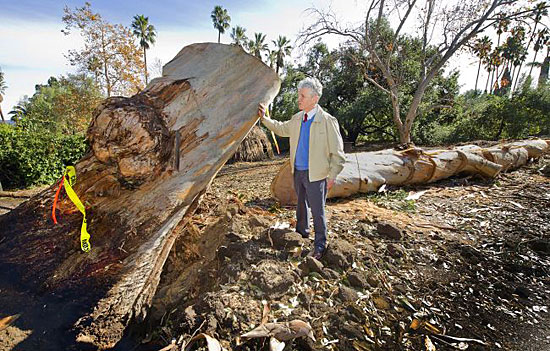
Arboretum CEO Richard Schulhof with one of the hundreds of felled trees. Photo/San Gabriel Valley Tribune
The Los Angeles County Arboretum and Botanic Garden, devastated by last December’s violent windstorms, has some beautiful plans for its fallen trees.
This week, the Board of Supervisors cleared the way for about 100 downed logs and branches to be given to artisans and wood artists to create pieces for a special exhibit and auction benefitting the Arboretum’s continued restoration. The project will be curated by the Arboretum’s artist in residence, Leigh Adams.
“We lost some 235 trees, and several hundred more were damaged,” says Arboretum CEO Richard Schulhof. “Some were total losses, and a lot of that wood has been chipped and is being returned to the soil as mulch here at the Arboretum.
“But we also had piles of tree branches—eucalyptus, oak, coral trees, fig trees. Some of it was very interesting wood that doesn’t grow anywhere else. So after the storm, we had people come up to us and say, ‘What are you going to do with this beautiful wood?’
“And we thought, ‘Why not ask some artists and artisans to do something that speaks to the next generation being planted, and that commemorates the trees that were lost?’”
Because the wood stockpiles are limited, Adams will invite artists to contribute: “We’re looking for people who know and visit the Arboretum, for whom it means something personally,” Schulhof says.
He adds that the auction will be held on the weekend of December 1-2, which is the anniversary of the devastating windstorms. Proceeds will go to the Arboretum Tree Fund established by the nonprofit Los Angeles Arboretum Foundation.
“It will help buy new plantings to replace what was lost,” says Schulhof, “and bring in the Arboretum’s next generation of trees.”
Posted 3/14/12
From pain, pure poetry in Room 219
February 15, 2012

ESL students at Fairfax High turned personal struggles into poetry for a recent performance. Photo/Clive Alcock
The players included a teenager from El Salvador missing her faraway mom, a boy from Africa’s Ivory Coast telling a family secret, a girl from Israel wrestling with what it means to be real, not “plastic.”
They spoke their lines with honesty and transparent emotion. Dressed all in black and moving about a spare stage, they took turns in the spotlight, young faces aglow.
Was this a pitch-perfect ensemble created by a Hollywood casting director? Or maybe an off-Broadway troupe preparing for a long theatrical run?
Hardly. This group came together in Karen Ritvo’s English as a Second Language class at Fairfax High School.
And the words they spoke were true—wrenched from the struggles of their real lives and spun into autobiographical poetry as part of a special collaboration with the Music Center.
When the students took the stage recently for a one-time-only performance at the Greenway Arts Alliance theater on the Fairfax campus, it was the culmination of a creative and transformative process that had started months ago with studying the art of others: Pablo Neruda’s Poetry and Alvin Ailey’s Revelations.
Soon, the students were coming up with revelations of their own, as they began crafting poems based on real experiences of struggle and change.
Some grappled with universal experiences of being a teen—a first kiss, or the heartache posed by a girl wanting to be “just friends.” But many sketched a very specific reality of being young, separated from loved ones and trying to make it in a strange land.
…All I have is her voice on the other
end of the line telling me “Baby everything is gonna be okay.”
That doesn’t take away the pain so I go to bed and wait for the
lights to go down so I can start to cry…
—“How it feels to miss my mom” by Daisy Juarez
Others wrote of the pain of dislocation, and of trying to make sense of a strange new language.
Some strangers just glance at me
This town is a maze
This foreign language sounds like unknown magical words
Colored signs make me confused
I need a new map
To go home to my adorable family
—“A New Map” by Yunha Kim
They described feeling invisible—or, even worse, too visible.
How shy she is in the center of this strange land
Everything she sees is unusual and unfamiliar
No one pays attention to her but she feels only tons of stares on the back of her head
—“Nothing Can Stop Me” by AiLing Lu
So why do you choose to be so rude
If all we want from you is your help to open up
I know you think I’m an alien
But like you I’m from earth
—Untitled, by Sheyla Jordan
Then it was time to move from writing to performing. Madeleine Dahm, a Music Center teaching artist from London, (yes, she’s from someplace else, too) worked with the students to stage a unique production that melded their original poetry with dance moves from Revelations and some recited lines from Neruda.
The show ended with each student speaking their name and where they’d come from: China. El Salvador. Ethiopia. Guatemala. Ivory Coast. Israel. Korea. Mexico. Uzbekistan.
The families, friends, fellow students and well-wishers who’d packed the small theater applauded enthusiastically, some wiping away tears.
“This is as good as education can get, I don’t care what level,” Fairfax principal Ed Zubiate said during a brief Q & A with the performers after the show.
Then it was over. The next week, the end of the semester would scatter the students, breaking up the world they’d formed in Room 219 and bringing down the curtain on all they experienced together.
But not on what they’d learned.
“After the performance, I realized that I don’t need to be afraid of anything,” said Natanel Giladi, 17, of Israel, whose poem “Who I really am” dealt with how hard it is to find one’s true self.
“I feel like wow, I finally said it,” said 17-year-old Kevin Miranda, of El Salvador, who wrote about losing his aunt and grandmother to cancer. “Because I didn’t even talk to my mom about what happened. It was just something I had inside that I didn’t have the opportunity to express. It was my first time on stage.”
“I learned that I’m not the only one who feels weird or feels sad in this country,” said Daisy Juarez, 19, also of El Salvador, who’d written about missing her mom. “They have their problems, too. It’s not only me. I learned not to judge.”

The poet-performers share a moment onstage with Dahm, kneeling at left, and Ritvo, standing center with scarf.
Posted 2/14/12




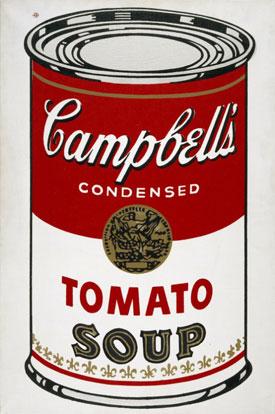
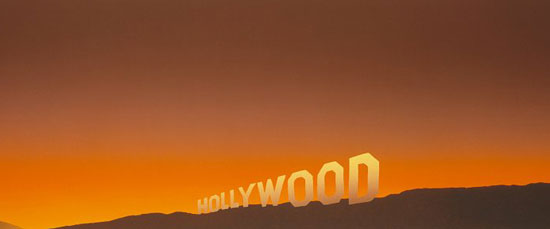
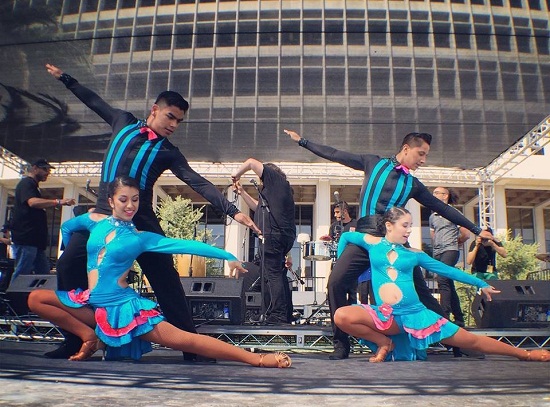

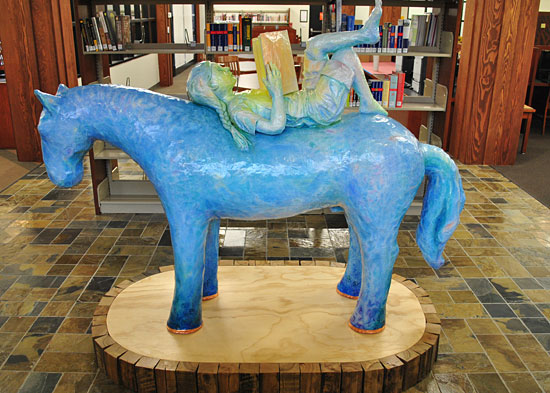






























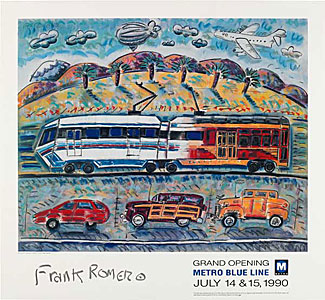





















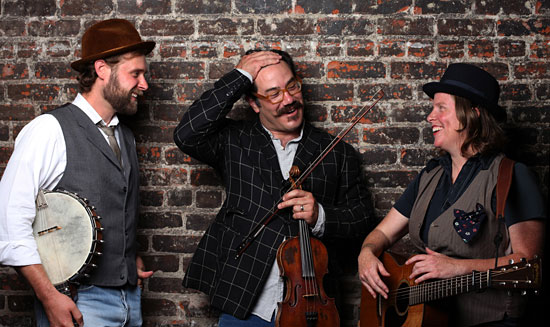















 405 bridge work causes a stink
405 bridge work causes a stink